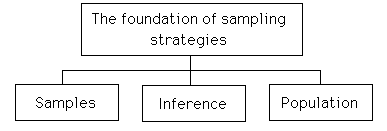Sampling
The term sampling refers to the selection of items from a
larger, specific group of items.
Figure 1. illustrates the three essential elements of the sampling
process

Sample
The term sample is
used in quantitative methods to denote the subset of elements, observations,
or measurements being studied (Sanders, 1990, Freund and Simon, 1991;
Triola, 1992).
Population
The term
population is used in Quantitative Methods to denote the set of all the
elements, observations or measurements being studied (Sanders, 1990, Freund
and Simon, 1991; Triola, 1992).
Inference
The term inference
refers to a deduction or a conclusion and is used in Quantitative Methods to
describe the process of relating information, derived from a sample, onto a
population.
The following table lists the
various types of sampling strategies used in research processes.
| Sampling Strategies |
| Probability
Sampling | Non-Probability Sampling |
| simple random sampling | consecutive
sampling |
| systematic sampling | convenience sampling |
| stratified
random | judgmental sampling |
| cluster sampling | |
Probability Sampling
Refers to sampling procedures that are based random
selection.
The
component of randomness ensures that each unit within the larger group
(the population) has an equal chance of being selected.
Randomness in sampling (or unit selection) reduces the effect of
bias in the research process.
Non-Probability Sampling
Refers to sampling strategies in which randomness of selection is
less important than meeting characteristics related to the research
question.
In studies of humans, non-probability samples will include
individuals who are determined "to suit" the research
question.
In
non-probability sampling...
Individuals who "suit" a
research project may be more likely to:
- be
accessible for the study;
- comply with a specific
regimen;
- demonstrate an expected outcome;
- infer to
a specific target "group" but not the general
population.

Types of Non-probability Samples
Convenience samples are used: - when other
procedures are not practical;
- in research which is restricted
by costs (e.g. student research);
- availability of
subjects;
- geographic proximity of samples;
- controversial nature of the study and the likelihood that subjects may
refrain from participation;
- in health research where informed
consent is required and may inhibit participants;
- when the
intrinsic bias of sampling is less important than observing an
outcome.
Consecutive
samples: - are conducted by selecting every
individual who meets the study criteria, and who is available during the
duration of the study;
- refer to an accessible group of
individuals but may not be inferential to a larger population. ;
- are problematic when the duration of the selection process is
inappropriate;
for example measuring an outcome over a month when a
year's worth of data is suggested.
Judgemental samples: - are
conducted by "handpicking" individuals for the study;
- resembles convenience sampling in its disregard for the effects of
bias;
- produce results which are related to an accessible group
of individuals but may not be inferential to a larger population;
- may be a first step in developing a larger
"probability-based" research study.

Types of Probability Samples
Random and independent sampling.:
- the term random implies that each member of the population has the same
chance of being selected for the sample;
- the term independent
implies that the selection of any one member in no way affects the selection
of any other member ;
- random sampling can generalize results to
a larger population.
Systematic Sampling: - is
effective when a complete list of the members of the population is available
for selecting the sample;
- the researcher could develop a
systematic method of selecting every other name or every "nth"
name, or some division of the total population.
Stratified random sample (common in
public opinion polls): - the population is
divided into subgroups or strata;
- each strata contains a
particular characteristic of interest but only one characteristic is
contained in any one strata;
- is most effective when the
variables of interest are closely related to the variables upon which the
strata are based;
- each stratum is sampled randomly and the
various sub-samples collected from the strata are combined to form the
sample;
but - proportioning the strata is important if the
researcher wishes to preserve the natural concentrations of sections within
the population.
Cluster Sampling: - is used to reduce the large
numbers of individuals needed for stratified and random methods;
- works best when we are studying intact groups (ie. students in classes
of a school);
- is used when it is either impossible or
impractical to obtain a list of all members of a defined population.

Considerations when sampling
Consideration #1:
Ideal accuracy in research is achieved only when all members
of a population are tested under controlled conditions.
Obviously,
because of costs, inaccessibility and limited time, all members of a
population could almost never be tested (except when a census is taken, then
there will be an effort to collect measures on the entire
population).
Consideration #2:
Always use the largest sample possible.
Since the researcher is always attempting to make inferences to a larger
population, the larger the sample the more likley it is to represent the
population.
Consideration #3:
Use a stratified random sample when attempting to
gain information about samples of subgroups. Consideration
#4:
When using
volunteers, always determine how these individuals differ from
non-volunteers.
Ask yourself, "Have you simply developed a study
on a bias sample?"
Consideration #5:
When developing a sampling
strategy, and computing sample size, be sure to consider: - that
some subjects may drop out;
- that the sample must be specific
to the research project;
- that the control and experimental
groups come from the same strata.

The concept of "Validity"
The term validity refers to the extent to
which we are measuring what we think we are
measuring.

Internal validity inference:
refers to the accuracy of the selected sample
as predictors of a larger population.

Two types of External Validity
Inference:
- the
generalization from the intended sample to the accessible population (where
the accessible population is defined as the subset of the target population
that is accessible to the researchers);
- the generalizations
that are made from the intended sample to the target populations, (where the
term target population refers to the largest population upon which
inferences will be made).
When developing a
sampling strategy:
Inclusion
Criteria:
refer to the strategy for selecting subjects that
will be eligible to participate in the study.
Exclusion
Criteria:
refer to the strategy for selecting subjects that
will not be eligible after they have been selected to participate in your
study.
 Click here to return to the Webulator Menu Page
Click here to return to the Webulator Menu Page
For more information, please contact:
Professor William J. Montelpare, Ph.D.,
Margaret and Wallace McCain Chair in Human Development and Health,
Department of Applied Human Sciences, Faculty of Science,
Health Sciences Building, University of Prince Edward Island,
550 Charlottetown, PE, Canada, C1A 4P3
(o) 902 620 5186
Visiting Professor, School of Healthcare, University of Leeds,
Leeds, UK, LS2 9JT
e-mail wmontelpare@upei.ca
Copyright © 2002--ongoing [University of Prince Edward Island]. All rights reserved.







 Click here to return to the Webulator Menu Page
Click here to return to the Webulator Menu Page